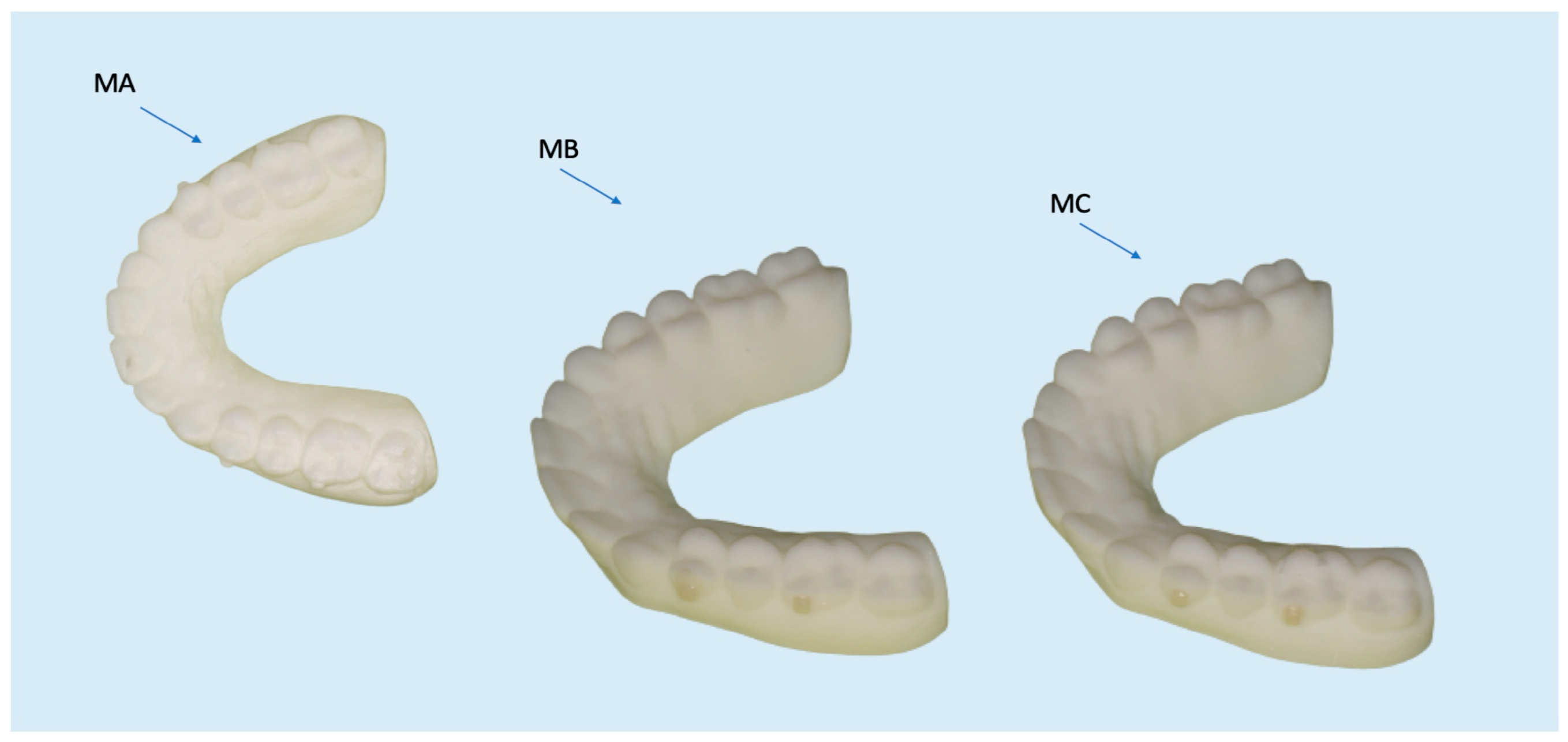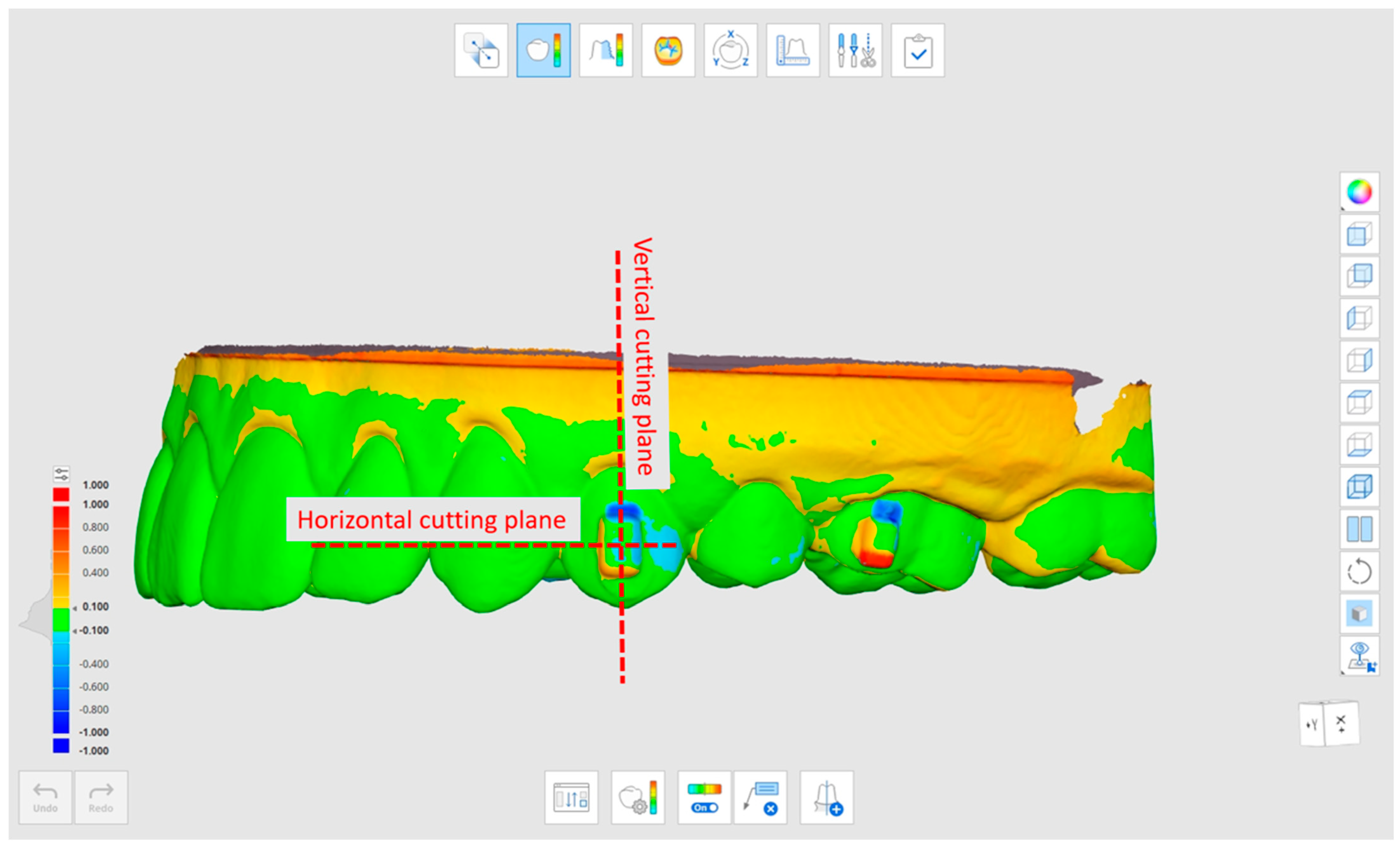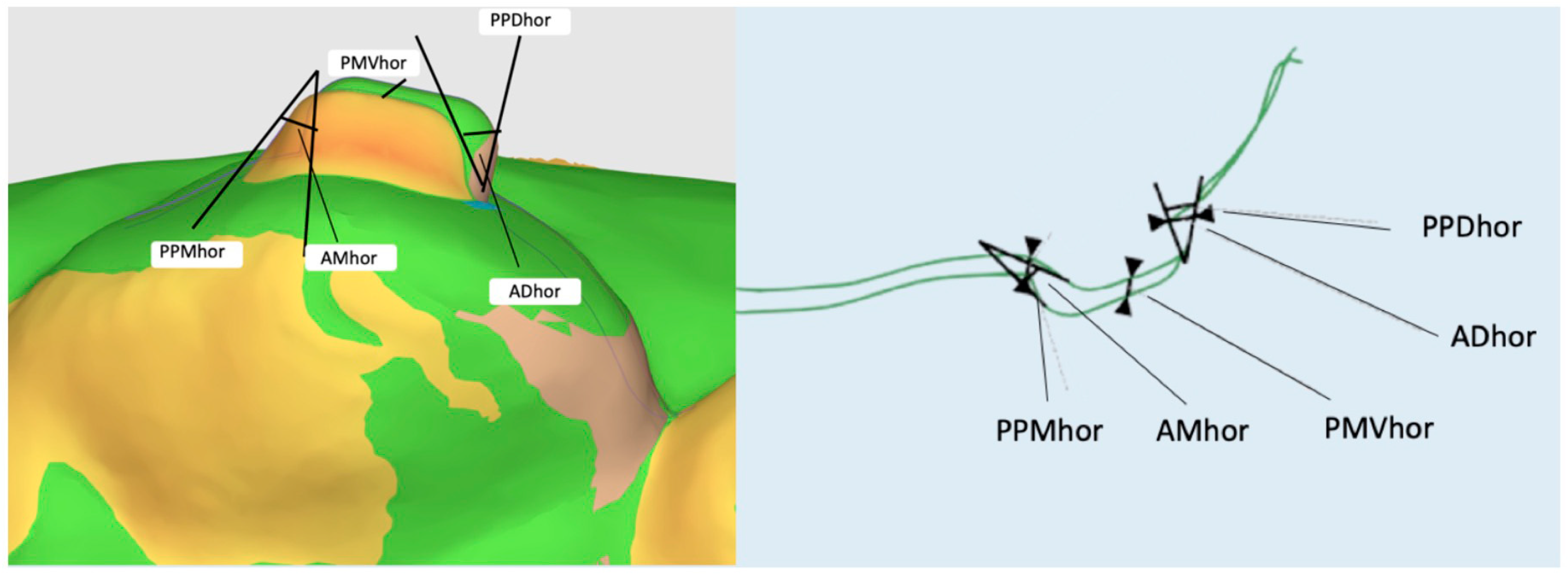Evaluation of the Clinical Variables Affecting Attachment Reproduction Accuracy during Clear Aligner Therapy
Abstract
1. Introduction
2. Materials and Methods
2.1. Material Characteristics and Curing Protocols Used in the Creation of the Attachment
2.2. Sample Selection and Operative Procedures
2.3. 3D Analysis
2.4. Statistical Analysis
2.4.1. Methodological Error
2.4.2. Power Analysis
3. Results
4. Discussion
5. Conclusions
Author Contributions
Funding
Institutional Review Board Statement
Informed Consent Statement
Data Availability Statement
Conflicts of Interest
References
- Putrino, A.; Barbato, E.; Galluccio, G. Clear Aligners: Between Evolution and Efficiency-A Scoping Review. Int. J. Environ. Res. Public Health 2021, 18, 2870. [Google Scholar] [CrossRef] [PubMed]
- Kuo, E.; Miller, R.J. Automated custom-manufacturing technology in orthodontics. Am. J. Orthod. Dentofac. Orthop. 2003, 123, 578–581. [Google Scholar] [CrossRef]
- Kravitz, N.D.; Kusnoto, B.; BeGole, E.; Obrez, A.; Agran, B. How well does Invisalign work? A prospective clinical study evaluating the efficacy of tooth movement with Invisalign. Am. J. Orthod. Dentofac. Orthop. 2009, 135, 27–35. [Google Scholar] [CrossRef] [PubMed]
- Lynch, N.M.; Shroff, B.; Carrico, C.K.; Sawicki, V.; Sabol, M.; Lindauer, S.J. Clear aligner therapy in the mixed dentition: Indications and practitioner perspectives. Am. J. Orthod. Dentofac. Orthop. 2023, 164, 172–182. [Google Scholar] [CrossRef] [PubMed]
- Nucera, R.; Lo Giudice, A.; Matarese, G.; Artemisia, A.; Bramanti, E.; Crupi, P.; Cordasco, G. Analysis of the characteristics of slot design affecting resistance to sliding during active archwire configurations. Prog. Orthod. 2013, 14, 35. [Google Scholar] [CrossRef][Green Version]
- Cordasco, G.; Lo Giudice, A.; Militi, A.; Nucera, R.; Triolo, G.; Matarese, G. In vitro evaluation of resistance to sliding in self-ligating and conventional bracket systems during dental alignment. Korean J. Orthod. 2012, 42, 218–224. [Google Scholar] [CrossRef]
- Tamer, İ.; Öztaş, E.; Marşan, G. Orthodontic Treatment with Clear Aligners and the Scientific Reality behind Their Marketing: A Literature Review. Turk. J. Orthod. 2019, 32, 241–246. [Google Scholar] [CrossRef]
- Liu, L.; Zhan, Q.; Zhou, J.; Kuang, Q.; Yan, X.; Zhang, X.; Shan, Y.; Li, X.; Lai, W.; Long, H. Effectiveness of an anterior mini-screw in achieving incisor intrusion and palatal root torque for anterior retraction with clear aligners. Angle Orthod. 2021, 91, 794–803. [Google Scholar] [CrossRef]
- Hennessy, J.; Al-Awadhi, E.A. Clear aligners generations and orthodontic tooth movement. J. Orthod. 2016, 43, 68–76. [Google Scholar] [CrossRef]
- Ryu, J.H.; Kwon, J.S.; Jiang, H.B.; Cha, J.Y.; Kim, K.M. Effects of thermoforming on the physical and mechanical properties of thermoplastic materials for transparent orthodontic aligners. Korean J. Orthod. 2018, 48, 316–325. [Google Scholar] [CrossRef]
- Nucera, R.; Dolci, C.; Bellocchio, A.M.; Costa, S.; Barbera, S.; Rustico, L.; Farronato, M.; Militi, A.; Portelli, M. Effects of Composite Attachments on Orthodontic Clear Aligners Therapy: A Systematic Review. Materials 2022, 15, 533. [Google Scholar] [CrossRef] [PubMed]
- Rossini, G.; Parrini, S.; Castroflorio, T.; Deregibus, A.; Debernardi, C.L. Efficacy of clear aligners in controlling orthodontic tooth movement: A systematic review. Angle Orthod. 2015, 85, 881–889. [Google Scholar] [CrossRef] [PubMed]
- Ravera, S.; Castroflorio, T.; Garino, F.; Daher, S.; Cugliari, G.; Deregibus, A. Maxillary molar distalization with aligners in adult patients: A multicenter retrospective study. Prog. Orthod. 2016, 17, 12. [Google Scholar] [CrossRef] [PubMed]
- Boyd, R.L. Complex orthodontic treatment using a new protocol for the Invisalign appliance. J. Clin. Orthod. 2007, 41, 525–547, quiz 523. [Google Scholar] [PubMed]
- Simon, M.; Keilig, L.; Schwarze, J.; Jung, B.A.; Bourauel, C. Treatment outcome and efficacy of an aligner technique--regarding incisor torque, premolar derotation and molar distalization. BMC Oral Health 2014, 14, 68. [Google Scholar] [CrossRef] [PubMed]
- Ho, C.T.; Huang, Y.T.; Chao, C.W.; Huang, T.H.; Kao, C.T. Effects of different aligner materials and attachments on orthodontic behavior. J. Dent. Sci. 2021, 16, 1001–1009. [Google Scholar] [CrossRef]
- Chen, W.; Qian, L.; Qian, Y.; Zhang, Z.; Wen, X. Comparative study of three composite materials in bonding attachments for clear aligners. Orthod. Craniofac. Res. 2021, 24, 520–527. [Google Scholar] [CrossRef]
- Weckmann, J.; Scharf, S.; Graf, I.; Schwarze, J.; Keilig, L.; Bourauel, C.; Braumann, B. Influence of attachment bonding protocol on precision of the attachment in aligner treatments. J. Orofac. Orthop. 2020, 81, 30–40. [Google Scholar] [CrossRef]
- Yazkan, B.; Ermis, R.B. Effect of resin infiltration and microabrasion on the microhardness, surface roughness and morphology of incipient carious lesions. Acta Odontol. Scand. 2018, 76, 473–481. [Google Scholar] [CrossRef]
- Aung, S.Z.; Takagaki, T.; Ikeda, M.; Nozaki, K.; Burrow, M.F.; Abdou, A.; Nikaido, T.; Tagami, J. The effect of different light curing units on Vickers microhardness and degree of conversion of flowable resin composites. Dent. Mater. J. 2021, 40, 44–51. [Google Scholar] [CrossRef]
- Park, S.B.; Son, W.S.; Ko, C.C.; García-Godoy, F.; Park, M.G.; Kim, H.I.; Kwon, Y.H. Influence of flowable resins on the shear bond strength of orthodontic brackets. Dent. Mater. J. 2009, 28, 730–734. [Google Scholar] [CrossRef] [PubMed]
- Kang, J.; Yi, M.; Chen, J.; Peng, M. Comparative assessment between bio-adhesive material and silk suture in regard to healing, clinical attachment level and width of keratinized gingiva in gingival recession defects cases. Sci. Prog. 2021, 104, 368504211011868. [Google Scholar] [CrossRef] [PubMed]
- Casavola, C.; Pappalettera, G.; Pappalettere, C.; Patronelli, M.; Renna, G.; Laurenziello, M.; Ciavarella, D. A full-field DIC analysis of the mechanical-deformation behavior of polyethylene terephthalate glycol (PET-G) aligners. J. Mech. Behav. Biomed. Mater. 2022, 134, 105391. [Google Scholar] [CrossRef]
- Kaur, H.; Khurelbaatar, T.; Mah, J.; Heo, G.; Major, P.W.; Romanyk, D.L. Investigating the role of aligner material and tooth position on orthodontic aligner biomechanics. J. Biomed. Mater. Res. B Appl. Biomater. 2023, 111, 194–202. [Google Scholar] [CrossRef] [PubMed]
- Bruno, G.; Gracco, A.; Barone, M.; Mutinelli, S.; De Stefani, A. Invisalign® vs. Spark™ Template: Which Is the Most Effective in the Attachment Bonding Procedure? A Randomized Controlled Trial. Appl. Sci. 2021, 11, 6716. [Google Scholar] [CrossRef]
- Park, S.Y.; Choi, S.H.; Yu, H.S.; Kim, S.J.; Kim, H.; Kim, K.B.; Cha, J.Y. Comparison of translucency, thickness, and gap width of thermoformed and 3D-printed clear aligners using micro-CT and spectrophotometer. Sci. Rep. 2023, 13, 10921. [Google Scholar] [CrossRef]
- Takahashi, M.A.; Bando, Y. Factors Affecting Thermal Shrinkage of Mouthguard Sheet during Thermoforming: Model Shape and Sheet Material Thickness. Mater. Sci. Appl. 2022, 13, 133–143. [Google Scholar] [CrossRef]
- Takahashi, M.; Satoh, Y.; Iwasaki, S.I. Effect of thermal shrinkage during thermoforming on the thickness of fabricated mouthguards: Part 2 pressure formation. Dent. Traumatol. 2017, 33, 106–109. [Google Scholar] [CrossRef]
- D’Antò, V.; Muraglie, S.; Castellano, B.; Candida, E.; Sfondrini, M.F.; Scribante, A.; Grippaudo, C. Influence of Dental Composite Viscosity in Attachment Reproduction: An Experimental in Vitro Study. Materials 2019, 12, 4001. [Google Scholar] [CrossRef]
- Lin, S.; Huang, L.; Li, J.; Wen, J.; Mei, L.; Xu, H.; Zhang, L.; Li, H. Assessment of preparation time and 1-year Invisalign aligner attachment survival using flowable and packable composites. Angle Orthod. 2021, 91, 583–589. [Google Scholar] [CrossRef]




| Materials | Template | Curing Lamps |
|---|---|---|
| Enaflow (Micerium) | Erkolen 0.8 Erkodent (PE) | UV Grand Valo lamp |
| Enamel plus HRI (Micerium) | Erkodur 0.8 Erkodent (PET-G) | Push light pressure (SCS) |
| Outcome | Description |
|---|---|
| PAPver | Maximum discrepancy between the two most apico-palatal points of the attachments of the two models |
| PCPver | Maximum discrepancy between the two most coronal–palatal points of the attachments of the two models |
| PMVver | Maximum discrepancy between the two middle-vestibular points of the attachments of the two models |
| AUver | Angle formed between the upper horizontal profiles of the attachments of the two models |
| ALver | Angle formed between the lower horizontal profiles of the attachments of the two models |
| PPMhor | Maximum discrepancy between the two most mesio-vestibular points of the attachments of the two models |
| PPDhor | Maximum discrepancy between the two most disto-vestibular points of the attachments of the two models |
| PMVhor | Maximum discrepancy between the two middle-vestibular points of the attachments of the two models |
| AMhor | Angle formed between the upper approximal profiles of the attachments of the two models |
| ADhor | Angle formed between the approximate lower profiles of the attachments of the two models |
| Materials | Curing Lamps | Template | PAPver | PCPver | PMVver | AUver | ALver | ||||||||||
|---|---|---|---|---|---|---|---|---|---|---|---|---|---|---|---|---|---|
| Mean ± SD (mm) | Min (mm) | Max (mm) | Mean ± SD (mm) | Min (mm) | Max (mm) | Mean ± SD (mm) | Min (mm) | Max (mm) | Mean ± SD (°) | Min (°) | Max (°) | Mean ± SD (°) | Min (°) | Max (°) | |||
| Composite flow | No pressure | CAD-PE | 0.33 ± 0.04 | 0.23 | 0.41 | 0.33 ± 0.17 | 0.09 | 0.63 | 0.62 ± 0.23 | 0.28 | 0.94 | 32.3 ± 3.4 | 26.19 | 36.74 | 19.36 ± 1.03 | 14.74 | 29.8 |
| Composite flow | No pressure | CAD-PEG | 0.30 ± 0.14 | 0.15 | 0.67 | 0.27 ± 0.07 | 0.13 | 0.4 | 0.41 ± 0.09 | 0.12 | 0.42 | 23.17 ± 5.03 | 19.2 | 27.31 | 6.1 ± 1.03 | 4.77 | 8.07 |
| Composite paste | No pressure | CAD-PE | 0.34 ± 0.05 | 0.22 | 0.41 | 0.25 ± 0.15 | 0.08 | 0.34 | 0.29 ± 0.08 | 0.26 | 0.53 | 34.59 ± 2.22 | 16.4 | 37.9 | 14.8 ± 2.3 | 10.3 | 18.21 |
| Composite paste | No pressure | CAD-PEG | 0.3± 0.14 | 0.18 | 0.73 | 0.23 ± 0.29 | 0.09 | 0.65 | 0.28 ± 0.09 | 0.05 | 0.37 | 26.57 ± 0.93 | 24.83 | 28.92 | 5.48 ± 3.4 | 3.4 | 9.3 |
| Composite flow | Pressure | CAD-PE | 0.26 ± 0.04 | 0.14 | 0.34 | 0.3 ± 0.1 | 0.18 | 0.53 | 0.42 ± 0.32 | 0.29 | 0.85 | 29.95 ± 0.7 | 25.72 | 32.2 | 17.93 ± 0.75 | 14.49 | 22.37 |
| Composite flow | Pressure | CAD-PEG | 0.24 ± 0.10 | 0.13 | 0.44 | 0.15 ± 0.07 | 0.05 | 0.31 | 0.16 ± 0.04 | 0.08 | 0.56 | 21.23 ± 3.2 | 19 | 23.25 | 6.4 ± 1.05 | 4.33 | 8.02 |
| Composite paste | Pressure | CAD-PE | 0.21 ± 0.05 | 0.13 | 0.33 | 0.21 ± 0.26 | 0.06 | 0.92 | 0.36 ± 0.1 | 0.23 | 0.63 | 35.41 ± 1.2 | 34.09 | 37.01 | 13.23 ± 0.68 | 12.26 | 14.73 |
| Composite paste | Pressure | CAD-PEG | 0.20 ± 0.07 | 0.08 | 0.37 | 0.19 ± 0.15 | 0.11 | 0.75 | 0.13 ± 0.07 | 0.04 | 0.31 | 25.8 ± 0.96 | 24.28 | 27.8 | 3.93 ± 2.8 | 2.87 | 5.2 |
| Materials | Curing Lamps | Template | PMMhor | PDDhor | PMVhor | AMhor | ADhor | ||||||||||
|---|---|---|---|---|---|---|---|---|---|---|---|---|---|---|---|---|---|
| Mean ± SD (mm) | Min (mm) | Max (mm) | Mean ± SD (mm) | Min (mm) | Max (mm) | Mean ± SD (mm) | Min (mm) | Max (mm) | Mean ± SD (°) | Min (°) | Max (°) | Mean ± SD (°) | Min (°) | Max (°) | |||
| Composite flow | No pressure | CAD-PE | 0.36 ± 0.27 | 0.27 | 0.29 | 0.33 ± 0.03 | 0.13 | 0.39 | 0.28 ± 0.18 | 0.11 | 0.6 | 13.29 ± 5.02 | 8.19 | 18.8 | 22.57 ± 4.66 | 15.68 | 27.29 |
| Composite flow | No pressure | CAD-PEG | 0.29 ± 0.11 | 0.11 | 0.25 | 0.27 ± 0.07 | 0.19 | 0.48 | 0.19 ± 0.04 | 0.07 | 0.25 | 13.22 ± 0.15 | 13.13 | 13.7 | 22.4 ± 2.87 | 21.44 | 25.4 |
| Composite paste | No pressure | CAD-PE | 0.17 ± 0.07 | 0.07 | 0.22 | 0.25 ± 0.04 | 0.04 | 0.37 | 0.18 ± 0.05 | 0.14 | 0.3 | 17.28 ± 2.02 | 13.16 | 22.5 | 23.88 ± 5.81 | 11.9 | 28.04 |
| Composite paste | No pressure | CAD-PEG | 0.15 ± 0.07 | 0.07 | 0.2 | 0.23 ± 0.04 | 0.13 | 0.29 | 0.17 ± 0.04 | 0.12 | 0.37 | 16.3 ± 5.01 | 14.24 | 21.8 | 22.98 ± 4.58 | 19.7 | 26.4 |
| Composite flow | Pressure | CAD-PE | 0.31 ± 0.21 | 0.21 | 0.23 | 0.3 ± 0.06 | 0.16 | 0.45 | 0.3 ± 0.07 | 0.19 | 0.49 | 22.4 ± 2.98 | 16.36 | 26 | 14.22 ± 0.98 | 12.12 | 16.4 |
| Composite flow | Pressure | CAD-PEG | 0.22 ± 0.15 | 0.15 | 0.19 | 0.15 ± 0.05 | 0.11 | 0.33 | 0.19 ± 0.04 | 0.13 | 0.29 | 21.3 ± 0.99 | 24.18 | 22.8 | 13.24 ± 2.99 | 11.18 | 15.8 |
| Composite paste | Pressure | CAD-PE | 0.16 ± 0.13 | 0.13 | 0.17 | 0.21 ± 0.06 | 0.09 | 0.35 | 0.19 ± 0.04 | 0.09 | 0.26 | 22.72 ± 4.6 | 18.08 | 27.05 | 18.68 ± 7.56 | 15.01 | 26.08 |
| Composite paste | Pressure | CAD-PEG | 0.14 ± 0.12 | 0.12 | 0.15 | 0.19 ± 0.05 | 0.07 | 0.27 | 0.16 ± 0.05 | 0.01 | 0.31 | 18.77 ± 2.53 | 16.5 | 21.15 | 17.77 ± 1.54 | 16.18 | 19.7 |
| PAPver | PCPver | PMVver | AUver | ALver | PMMhor | PDDhor | PMVhor | AMhor | ADhor | |
|---|---|---|---|---|---|---|---|---|---|---|
| PE vs. PET-G pressure | 0.03 a | 0.01 a | 0.02 a | 0.04 a | 0.05 a | 0.03 a | 0.02 a | 0.01 a | 0.04 a | 0.05 a |
| PE vs. PET-G no pressure | 0.9 b | 0.04 a | 0.5 b | 0.03 a | 0.02 a | 0.01 a | 0.03 a | 0.02 a | 0.24 b | 0.04 a |
| Composite paste vs. composito flow pressure | 0.04 a | 0.02 a | 0.16 b | 0.01 a | 0.04 a | 0.02 a | 0.01 a | 0.05 a | 0.04 a | 0.02 a |
| Composite paste vs. composito flow no pressure | 0.07 b | 0.17 b | 0.01 a | 0.02 a | 0.03 a | 0.04 a | 0.14 b | 0.03 a | 0.01 a | 0.19 b |
| Composite Paste vs. Composite Flow | PE vs. PETG | |||
|---|---|---|---|---|
| Total Ver pressure | 0.04 a | 0.01 a | ||
| Total Ver no pressure | 0.22 b | 0.27 b | ||
| Total Hor pressure | 0.03 a | 0.02 a | ||
| Total Hor no pressure | 0.17 b | 0.31 b | ||
| Composite Paste | Composite Flow | PE | PET-G | |
| AUver vs. ALver pressure | 0.04 a | 0.05 a | 0.03 a | 0.02 a |
| AUver vs. ALver no pressure | 0.03 a | 0.02 a | 0.01 a | 0.03 a |
| AMhor vs. ADhor pressure | 0.01 a | 0.04 a | 0.02 a | 0.05 a |
| AMhor vs. ADhor no pressure | 0.02 a | 0.03 a | 0.04 a | 0.01 a |
| Composite Paste vs. Composite Flow | PE vs. PET-G | |
|---|---|---|
| Total Ver pressure | 0.05 a | 0.03 a |
| Total Ver no pressure | 0.14 b | 0.33 b |
| Total Hor pressure | 0.02 a | 0.01 a |
| Total Hor no pressure | 0.29 b | 0.25 b |
Disclaimer/Publisher’s Note: The statements, opinions and data contained in all publications are solely those of the individual author(s) and contributor(s) and not of MDPI and/or the editor(s). MDPI and/or the editor(s) disclaim responsibility for any injury to people or property resulting from any ideas, methods, instructions or products referred to in the content. |
© 2023 by the authors. Licensee MDPI, Basel, Switzerland. This article is an open access article distributed under the terms and conditions of the Creative Commons Attribution (CC BY) license (https://creativecommons.org/licenses/by/4.0/).
Share and Cite
Bellocchio, A.M.; Portelli, M.; Ciraolo, L.; Ciancio, E.; Militi, A.; Peditto, M.; Barbera, S.; Nucera, R. Evaluation of the Clinical Variables Affecting Attachment Reproduction Accuracy during Clear Aligner Therapy. Materials 2023, 16, 6811. https://doi.org/10.3390/ma16206811
Bellocchio AM, Portelli M, Ciraolo L, Ciancio E, Militi A, Peditto M, Barbera S, Nucera R. Evaluation of the Clinical Variables Affecting Attachment Reproduction Accuracy during Clear Aligner Therapy. Materials. 2023; 16(20):6811. https://doi.org/10.3390/ma16206811
Chicago/Turabian StyleBellocchio, Angela Mirea, Marco Portelli, Ludovica Ciraolo, Elia Ciancio, Angela Militi, Matteo Peditto, Serena Barbera, and Riccardo Nucera. 2023. "Evaluation of the Clinical Variables Affecting Attachment Reproduction Accuracy during Clear Aligner Therapy" Materials 16, no. 20: 6811. https://doi.org/10.3390/ma16206811
APA StyleBellocchio, A. M., Portelli, M., Ciraolo, L., Ciancio, E., Militi, A., Peditto, M., Barbera, S., & Nucera, R. (2023). Evaluation of the Clinical Variables Affecting Attachment Reproduction Accuracy during Clear Aligner Therapy. Materials, 16(20), 6811. https://doi.org/10.3390/ma16206811








